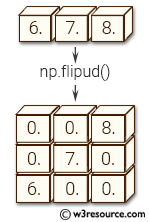

Well, We have done a brief discussion on vstack() and hstack(). Hstack() performs the stacking of the above mentioned arrays horizontally. Print (out_array) hstack on multiple numpy array Out_array = numpy.hstack((array_1, array_2,array_3,array_4)) As we have seen the so many example of vstack(). The vstack() function stacks the sequence of array vertically and hstack() stacks the horizently. Difference between vstack and hstack –īoth numpy works in the same way with the a difference of axis. Out_array = np.concatenate((array_1, array_2,array_3,array_4), axis=0) We can achieve the same using ncatenate(tup, axis=0). Vstack does the concatenate operations over the arrays. Out_array = numpy.vstack((array_1, array_2,array_3,array_4))Ģ.2 n ncatenate(tup, axis=0) works same – The only condition is with it that all numpy array must be same on shape( column wise). But Here we will apply vstack() on four numpy arrays.Actually we can add any number of numpy array in the tuple. In the above example, We have stacked two numpy array. Other Examples for vstack numpy- 2.1 vstack for more than two array. Out_array = numpy.vstack((array_1, array_2))Īs we have seen that vstack() returns the out_array. out_array = numpy.vstack((array_1, array_2)) We will use numpy.vstack() function like below. In order to stack the two or more numpy array. We have just imported numpy module and create array using numpy.array() function. numpy.vstack(tup) accepts the tuple of arrays as parameter. If youĬan figure out a way to do that, I would be very grateful for it.Numpy vstack stacks the different numpy arrays into single numpy array vertically. That said, none of this is explicitly stated in the docs right now. stack and concatenate (coupled with numpy'sĪxis manipulation routines) are enough for nearly every use case. Of course, we can't really do that because of numpy's very strongīackwards compatibility guarantees, but I would like to nudge users awayįrom using these functions. If I had my way, I would actually consider deprecating vstack/hstack In contrast, stack and concatenate are a betterįit for NumPy as a library for manipulating N-dimensional arrays. The way that vstack/hstack/dstack handle arrays ofĭifferent dimensionality is quirky and difficult to predict for most people Stack, because these routines are less general and powerful than stackĪnd concatenate. I actually intentionally omitted vstack and hstack from the docstring for
NUMPY VSTACK VS HSTACK FULL
It's worth taking a look at the discussion in my original PR for the full

Numpy.stack is actually pretty new - it only was released in NumPy 1.10. You should really prefer concatenate or stack (keeping in mind it was addedĭon't forget row_stack and column_stack in this discussion either. saying "this function continues to be supported for backcompat, but Or subclassing.) I'd be +1 to putting a prominent note at the top of hstackĮtc. (Other examples that come to mind: no warnings against matrix We should definitely do a better job of conveying actual usage guidelines If you can figure out a way to do that, I would be very grateful for it. The *stack functions are mostly just noise. stack and concatenate (coupled with numpy's axis manipulation routines) are enough for nearly every use case. Of course, we can't really do that because of numpy's very strong backwards compatibility guarantees, but I would like to nudge users away from using these functions. If I had my way, I would actually consider deprecating vstack/ hstack instead. In contrast, stack and concatenate are a better fit for NumPy as a library for manipulating N-dimensional arrays. The way that vstack/ hstack/ dstack handle arrays of different dimensionality is quirky and difficult to predict for most people without experimentation. I actually intentionally omitted vstack and hstack from the docstring for stack, because these routines are less general and powerful than stack and concatenate.

It's worth taking a look at the discussion in my original PR for the full context: #5605.


 0 kommentar(er)
0 kommentar(er)
